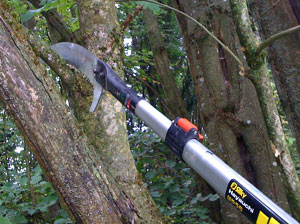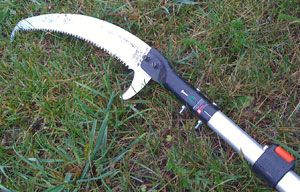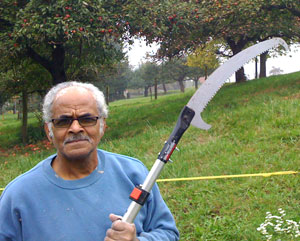Why and how should you prune your woodland trees?

There are several good reasons for pruning trees in your woodland. Here are some:
- to clear tracks and paths
- to improve the shape of the trees for timber purposes
- for safety
- to improve appearance
A related reason that is usually omitted by forestry books is that pruning can be great fun or at least very satisfying going round your woodland improving the future shape of the trees. Compared with gardening woodland tree pruning is on a much larger scale, and occasional mistakes are less serious. You also don't need to collect up the branches you've cut off. Tree surgeons and foresters usually call these cuttings the "arisings" and in a woodland they can usually be left to decay near to where they have been cut, ideally in habitat piles.
Pruning to improve shape will add timber value in future years
If you are pruning to improve the shape of a potential timber tree you will want ideally to catch the tree when it is quite young before unwanted branches have become too big. When pruning oak and ash you don't need to prune every tree: in fact something like one in 5 or one in 10 trees can be pruned - you will want to have an eye for which trees are going eventually to make the mature timber trees. The importance of producing trees with good shape is illustrated by this comparison - firewood grade timber sells for about £20 per cubic metre whereas planking grade timber will sell for about £200 per cubic metre (both figures on the basis of felled and at roadside). Many oak and ash trees inevitably develop forks and grow large sideways branches so that by formative pruning you can remove these branches at at early stage in the tree's growth. The general rule is prune little and often rather than leaving branches to get too big and this is the advantage of doing your own management of a small wood - such regular pruning operations are practical.
Some trees simply don't need much pruning at all - conifers are self-pruning, and trees such as birch, alder, maple, willow and shrubs can generally all be left to their own devices. Some others, such as poplar, are at the other extreme and usually they all need pruning, but in a typical woodland with some broadleaved trees some selective pruning will be very useful.
 What pruning equipment should you use and how do you cut a branch?
What pruning equipment should you use and how do you cut a branch?
Depending on the height and thickness of the branches to be cut, you can use secateurs, a hand saw, loppers or a pole saw. Pole saws are used for anything above head height and and using them for high pruning and can be very satisfying - gravity seems to do most of the work. There is a short video here demonstrating high pruning with a long handled saw (pole saw):
http://www.woodlandstv.co.uk/videos/watch/8/using-a-long-handled-saw
A good pole saw with blade will cost you about £100 but the blades last a long time and can be sharpened and re-set or even replaced separately.
Branches should be cut near to the trunk but not so near that you create a large scar for the tree to heal - an angled cut can minimise the surface area that the tree needs to repair. You will want a clean, precise cut so that you do not tear the bark down the stem and you should try to avoid leaving "stubs". You should aim to cut close to the main stem but not so close that you cut into the "bark ridge" or "bark collar". As to choosing which branches to cut, you will be trying to do two things: remove some lower branches and promote single "leaders". On a tree like cherry you will be cutting the lower, coarser branches before they get to 3 cms in diameter, whereas for ash and oak you will be mainly trying to avoid the emergence of more than one "leader" - you are trying to create what will become a straight stem rather than a forked trunk. With larger branches you should make your first cut about 1' away from final cut to take the weight off so that the final cut is as neat as possible.
What time of year should I be pruning?
 Generally the best time to prune broadleaved trees is from Mid-June to Mid-September although you can also prune oak, ash and poplar in January and December. You should avoid pruning trees in Spring and Autumn. There is an excellent free guide to pruning with illustrations which you can download here, written by Simon Greenhouse and sponsored by Silky Fox who are an excellent supplier of pole saws and other pruning equipment. This guide, called "Pruning for Quality," has really good illustrations of which branches to choose and how to cut them.
Generally the best time to prune broadleaved trees is from Mid-June to Mid-September although you can also prune oak, ash and poplar in January and December. You should avoid pruning trees in Spring and Autumn. There is an excellent free guide to pruning with illustrations which you can download here, written by Simon Greenhouse and sponsored by Silky Fox who are an excellent supplier of pole saws and other pruning equipment. This guide, called "Pruning for Quality," has really good illustrations of which branches to choose and how to cut them.
Comments are closed for this post.
Discussion
Woodland Heritage have produced three practical laminated guides for use in the field relatintg to pruning and planting, which you might find useful:
‘High Pruning for Profit’
‘Formative Pruning’
and ‘Estabishment of Broadleaves’
See http://www.woodlandheritage.org.uk for further information.
Thank you

One thing to be wary of: if, like us, your woodland is protected by a Tree Presevation Order you are not permitted to prune your trees without planning permission, which usually requires an assessment of each individual tree by a professional, and details of the exact work to be carried out. We are permitted to fell trees under our felling licence, but not to prune them.
Sarah Walters
30 November, 2010